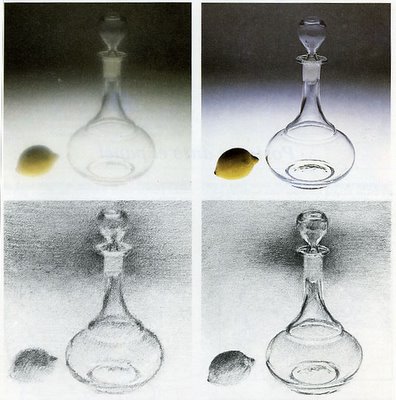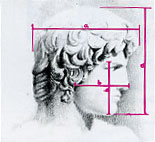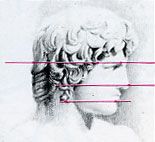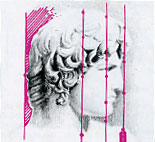20 November 2005
Pencil Drawing, Study of Proportions
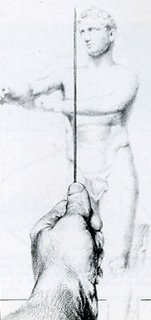 A very important topic when starting to draw from live models, is the correct measurement of the proportions they have, and also the correct translation of the proportions to the canvas. As you may have experienced, it is not enough to just watch carefully, it is also necessary to measure and compare. A stick and a weight attached to a string are the two of the most common methods when starting to draw.
Using a simple stick of any material (30 / 35 cms length). The artist can get the proportions of the model. Grabbing the stick by one of the sides, with the arm stretched parallel to the ground at eye height, and closing one eye we can measure and compare the heights and widths of the model.
The string method works the same, but is is special because it assures a perfect vertical line.
Examples of using the stick and the string
Using the stick and string, first, we compare heights and widths and we relate them to each other. With the stick we can also locate points that coincide on horizontal lines. Finally, using the string we search other elements of the model on vertical lines.
The "framing" or lineal representation is a must in every drawing. Thanks to this process, the artist caries the measures and proportions of the model to the paper. Getting good at locating proportions and adjusting them to the drawing is a task that requires a lot of practice and precision. Aim first at just finding the porportions do not rely so much on the form of the object at this stage.
A very important topic when starting to draw from live models, is the correct measurement of the proportions they have, and also the correct translation of the proportions to the canvas. As you may have experienced, it is not enough to just watch carefully, it is also necessary to measure and compare. A stick and a weight attached to a string are the two of the most common methods when starting to draw.
Using a simple stick of any material (30 / 35 cms length). The artist can get the proportions of the model. Grabbing the stick by one of the sides, with the arm stretched parallel to the ground at eye height, and closing one eye we can measure and compare the heights and widths of the model.
The string method works the same, but is is special because it assures a perfect vertical line.
Examples of using the stick and the string
Using the stick and string, first, we compare heights and widths and we relate them to each other. With the stick we can also locate points that coincide on horizontal lines. Finally, using the string we search other elements of the model on vertical lines.
The "framing" or lineal representation is a must in every drawing. Thanks to this process, the artist caries the measures and proportions of the model to the paper. Getting good at locating proportions and adjusting them to the drawing is a task that requires a lot of practice and precision. Aim first at just finding the porportions do not rely so much on the form of the object at this stage.
15 November 2005
Drawing On Creativity: How To Trick Your Brain
10 November 2005
Book Review - Pencil Drawing Techniques
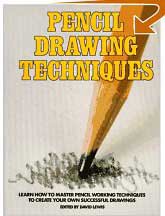 "Pencil Drawing Techniques" Flipping through this book, my jaw dropped in amazement at the examples in this book. Near the end, the illustrations of zoo animals (tigers, horses, etc) were so life-like! The artist really know how to shade. I instantly brought the book.
"Pencil Drawing Techniques" Flipping through this book, my jaw dropped in amazement at the examples in this book. Near the end, the illustrations of zoo animals (tigers, horses, etc) were so life-like! The artist really know how to shade. I instantly brought the book. Let me tell you, this Pencil Drawing Techniques book is very complex and loaded with information. There are lots of text for an art book. First, the book goes over the basics of shapes and different shades of pencil lead (from hard 6H to very soft 8B, the "#2 pencil" is near the middle). Then we go over shading. The book is primarily focusing on different shading and strokes techniques in order to get that "life-like" realism in your drawing. In my personal experience, trying to obtain that level takes many hours and many practice. If you are the type who gives up easily, then Pencil Drawing Techniques isn't for you. Nobody said drawing is easy. Or, if you are only interested in drawing nice line-arts (and letting a computer do the rest), then this book is NOT for you as well. However, if you want to draw to the highest realism with just a pencil, then this book is worth considering.
I should also mention that a small chapter of Pencil Drawing Techniques is devoted to color pencils (whereas the rest, or 90% of the book, is on graphite pencil). Buy Book At Pencil Drawing Techniques07 November 2005
Still Life Pencil Drawing
 What is a Still Life?
Still Life is an art term, that refers to a special kind of picture. It represents an arrange of inanimate objects (hence the name) such as a bowl, a cup or fruits. Usually the arrangement is made according to the artist's purpose. A Still life pencil drawing can be symbolic, with an underlying meaning, or aesthetic, in which case the purpose is to communicate beauty.
About Still Life Pencil Drawings
A still life work can have many purposes. If we work in color it can help us understand how color acts in real life, how the light bounces, and how an arrangement of colors can bring a special mood to the painting. Using colored pencils we can begin studies about color, and work in the finest details. But in the case of black and white pencil drawings, the purpose of the still life pencil drawing is different. A still life pencil drawing can help us study shapes and see how they interact on our eyes, we learn how to measure correct proportions and how they can make the difference betwen a good drawing and a remarkable drawing.
When we get into shading, we then study tonal values. There are no colors here so we must learn how to see things in black and white mode, and correctly define which are going to be the dark and light areas on our still life pencil drawing.
Still lifes are the most available subjects in the world, and while some people may consider still life drawing boring, te fact is they teach us a lot. When you have no idea of what to draw, just make an arrangement of things you have at your house and start your still life pencil drawing. Don't take just as bring cups and fruits, but instead focus on what you can learn from this.
BTW, you can click on the pics to see them bigger.
What is a Still Life?
Still Life is an art term, that refers to a special kind of picture. It represents an arrange of inanimate objects (hence the name) such as a bowl, a cup or fruits. Usually the arrangement is made according to the artist's purpose. A Still life pencil drawing can be symbolic, with an underlying meaning, or aesthetic, in which case the purpose is to communicate beauty.
About Still Life Pencil Drawings
A still life work can have many purposes. If we work in color it can help us understand how color acts in real life, how the light bounces, and how an arrangement of colors can bring a special mood to the painting. Using colored pencils we can begin studies about color, and work in the finest details. But in the case of black and white pencil drawings, the purpose of the still life pencil drawing is different. A still life pencil drawing can help us study shapes and see how they interact on our eyes, we learn how to measure correct proportions and how they can make the difference betwen a good drawing and a remarkable drawing.
When we get into shading, we then study tonal values. There are no colors here so we must learn how to see things in black and white mode, and correctly define which are going to be the dark and light areas on our still life pencil drawing.
Still lifes are the most available subjects in the world, and while some people may consider still life drawing boring, te fact is they teach us a lot. When you have no idea of what to draw, just make an arrangement of things you have at your house and start your still life pencil drawing. Don't take just as bring cups and fruits, but instead focus on what you can learn from this.
BTW, you can click on the pics to see them bigger.
03 November 2005
Pencil Drawing Techniques – Smooth Shading
 A Pencil Drawing technique that is very hard to master and at the same time can bring a photo realistic finish, is the smooth shading technique. This pencil drawing technique consists of shading gradually the drawing with the pencil tilted, to give it a 3D look. This can be done only using the pencil or with the aid of a tool to diffuse the tones.
A Pencil Drawing technique that is very hard to master and at the same time can bring a photo realistic finish, is the smooth shading technique. This pencil drawing technique consists of shading gradually the drawing with the pencil tilted, to give it a 3D look. This can be done only using the pencil or with the aid of a tool to diffuse the tones.This pencil drawing technique requires patience, and concentration. You have to really have control over the pressure of the pencil, and at the same time choose the right pencil hardness to achieve the desired results. You also have to keep your work clean, because sometimes this type of shading can go wrong, and your work ends up looking bad.
I’ve found some resources on the web that you can check if you want to know more about this technique. I will be posting technique tutorials here too, once I have all the things I’m gathering. Check back once in a while, to see if they’re online.
Resources:
Related Pencil Drawing Technique posts: Cross Hatching, Learning How to Draw with the Grid Method, 5 point perspective… more

